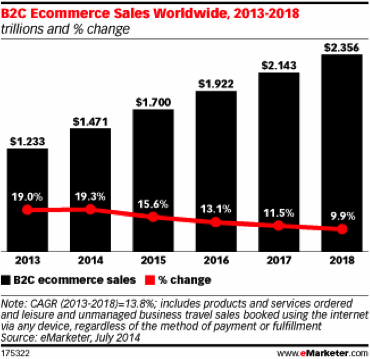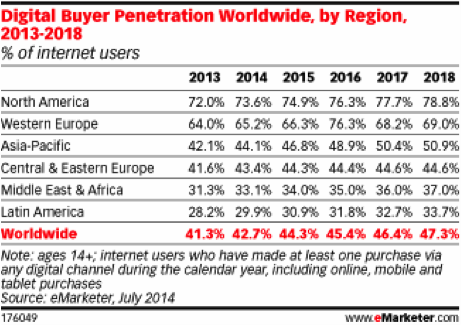50% of Australians turn to online shopping & 5 new trends that are here to stay
The number of consumers purchasing goods online continues to increase according to research from the Australian Bureau of Statistics (ABS). The ABS estimated that Australians spent $15.9 billion on online retail in the 12 months to September 2014.
The number of Australians turning to the internet for shopping is more than 50 percent, according to Roy Morgan Research. Internet shopping has reached mainstream status and any retailers that want to ensure a sustainable future for their business can’t afford to ignore the online channel anymore – it’s simply not an option.
Do you want to participate in the online growth? Then you need to put a focus on 5 new trends in the online market: Mobile Shopping, Reverse Showrooming, Omni-Channels, Virtual Fitting Rooms and Mass-Customization.
Growth in Online Shopping
As Internet usage continues to mature around the world, B2C e-commerce sales worldwide are estimated to reach $2.356 trillion in 2018, according to figures from eMarketer.
The increase of e-commerce sales in the Asia-Pacific region is tied to a growing base of digital buyers, and as more new buyers come online, sales will increase. eMarketer also expects Asia-Pacific to become the leading region for e-commerce sales in 2015, representing 33.4% of the total market.
According to eMarketer, Australians are Asia Pacific’s most avid digital buyers. The top digital purchase categories for Australians are clothing, shoes and accessories, with nearly eight in 10 digital buyers in Australia reportedly buying these items via the internet in the past year.
In the future, we can expect consumers will accept new technologies at a quicker rate. The challenge for retailers is therefore to be flexible in order to deal with this new technology.


1. Mobile Shopping
PC transactions still lead the way and have remained stable over the past three years while the level of m-commerce has increased substantially. Mobile offers retailers a powerful platform to customise offerings, connect better with their customers and ultimately drive stronger retail sales. According to research, the use of smartphones to make online purchases has grown 101 per cent in the past year, from 2013-2014.
It is expected that the number of purchases via smartphones and tablets will rise significantly in the near future which means that retailers will have to support more devices to stay competitive.
However, while growth in online sales continues to outpace traditional retail, brick-and-motor remains the primary channel for retailers in Australia. In dollar terms, it’s estimated that Australians spent $15.9 billion on online retail in the 12 months to September 2014. This level is equivalent to 6.7% of spending at traditional bricks and mortar retailers.
2. Omni-Channel
This fusion of online and off-line is also called omni-channel, which primarily relates to the brand experience of the customer. Omni-channel goes beyond virtual web shops or the doors of a store. Customers have attached a freedom to choose what, when and where they buy products. In this strategy, more customers see no difference between the channels and the user experience will be the same. A great example of omni-channel is the 150-year-old US department store, Macy’s.
Macy’s adapted its team structure, inventory and marketing to delight its modern core audience: 25-54 female omni-channel shoppers.
3. Reverse Showrooming
Often consumers use the Internet to do research into products and then go to the physical store where the products are actually bought. Here it is important for businesses that the customer has a positive experience, both in the physical store and online.
In this way, customers feel more involved with the company and what it has to offer, which in turn could have a positive effect on the attractiveness of the physical stores.
A good example of such integrated experiences is an app that was created by IKEA. IKEA created an interactive catalogue that makes choosing furniture pieces to fit your room easier.
Source: IKEA, July 2013
4. Virtual Fitting Rooms
Research shows that the number of items returned by consumers online is significantly higher than in physical stores. To reduce this number, e-retailers use various tools, such as zoom-in tool, and photos in different sizes.
Online experience
Offering virtual fitting rooms makes the overall online experience more enjoyable. Your visitor gets the same feeling as they would in the physical store whilst shopping online. For the best customer fitting room experience online, have a look at Superdry’s virtual catwalk video which delivers a high level of shopper engagement.
Less returns
A retailer can give a unique experience to shoppers with this simple technology. Furthermore, research shows that online stores that incorporate virtual fitting rooms, have significantly fewer items returned.

5. Mass Customization
Mass customization is the use of flexible, computer-aided manufacturing systems to produce custom output. Mass customization is the new frontier in business competition for both manufacturing and service industries.
Consumers are becoming less satisfied. This is because the role of the consumer increasingly changes from passive to active and they also want to be heard by companies.
In the last decade or so, we’ve seen features that allow each shopper to customize his or her product or service with a range of components, for instance, when ordering a computer, shoes or smartphone. Such configured mass customization is bound to reach ever-greater levels of sophistication. One example of a brand that’s taken this concept on successfully is retail giant – Nike.
Nike’s ID program allows the sporting giant’s more fashion-oriented buyers to determine the finish on a range of the company’s athletic footwear, from team colours for your pub, to eye searing neon tones to match your existing outfits.
More online shopping leads to greater fusion
Does this mean that customers in the future will shop more online, as it is often predicted, or will the developments and integration of these technologies ensure that people will go back to shopping in physical stores?
The concept of omni-channel will be increasingly used by businesses to optimise the buying process and user experience. Where customers will buy their products in five years only the future can tell, but the research indicates that customers will use multiple devices and channels to purchase goods, and for your business to be competitive it’s necessary that you create a good overall user experience both online, and in physical stores.
Sarah Tramm
She enjoys the many areas of business communication and branding, and one day hopes to settle down in Australia. You can keep up with Sarah on Twitter with the handle @SarahTramm
Latest posts by Sarah Tramm (see all)
- The Future Of Shopping - January 21, 2015






